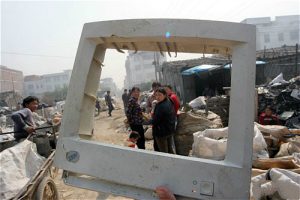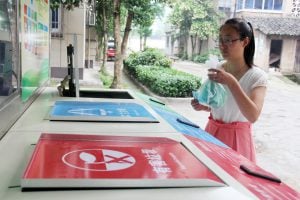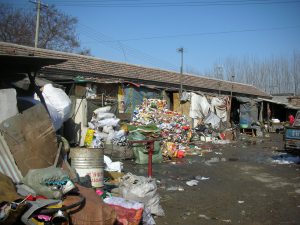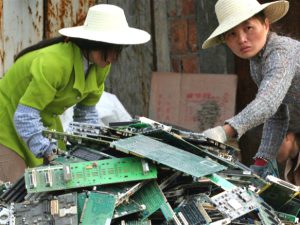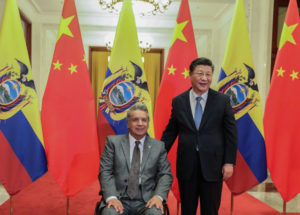Can better design and use of materials help us eliminate waste from our economies? Chinese and European policymakers seem to think so. Circular Economy thinking, as it’s known, is also attracting interest from major multinationals such as Coca Cola, and is profoundly impacting the way businesses design their products.
A circular approach could save billions of dollars that is currently spent on landfill and incinerating rubbish, cleaning up waste and managing pollution. Eager to develop more sustainable, resource-efficient economies, it has become a natural point of convergence for the Chinese government and EU.
We spoke with Jocelyn Blériot, executive officer of the Ellen MacArthur Foundation, which advocates for a global shift to a circular economy at the Our Oceans Conference in Malta organised by the European Commission.
This interview has been condensed and edited for clarity.
chinadialogue: In an era of diminishing natural resources, islands of floating plastic, and mountains of e-waste, what solutions are you proposing?
Jocelyn Blériot: If you look at the way industrial models have evolved since the industrial revolution, they have followed an extractive mode that takes resources out of the ground, makes products and then discards them. It’s massively wasteful and polluting even though it has served its purpose and lifted billions out of poverty.
In the context of resource scarcity, the negative impacts of this model have come to the fore and both business and government recognise there is a need for a different system that can bring resilient long term prosperity and decouple growth from the negative impacts. So that’s what we are working on; a circular economy.
Plastic is an iconic material in the modern economy; it’s all over the place, and it’s useful. But the volumes are growing rapidly. It’s almost the archetype of linear materials, in the sense that it gets made from a finite resource, turned into products, gets discarded, but because of its nature it accumulates rapidly. We see consumption and production levels rising rapidly.
This is why we want to take an upstream redesign approach to plastics packaging. For some other segments it's about looking at innovative distribution models; how to get products to consumers and citizens without multiplying the plastic waste.
Another part of the strategy is to look at improving recycling quality and making sure what is recycled doesn’t get degraded into a lower quality material.
CD: The EU Circular Economy Package proposed in December 2015 set a target for member states to reuse and recycle 65% of packaging by 2025, rising to 75% in 2030. Do you think this goes far enough?
JB: New targets are still being discussed. There is a “trilogue”, which is a dialogue mechanism involving three parties: the Commission, the Council, and the Parliament. Member states have a strong voice in that dialogue through the Council. Of course, there is a lot of talk about watering down those targets. But at the end of the day this is still a downstream look at it.
What’s interesting in the European Commission’s Circular Economy Package is the emphasis on upstream and on the design, what gets put on the market.
If you create a system whereby nothing becomes waste, through upstream design such as the Ecodesign Directive, or extended producer responsibility, then of course the amount of waste coming down the line is going to reduce naturally.
This is an optimistic view, discussions are going to be very difficult between member states and the targets of recycling of municipal waste will be important in the transition period.
CD: Five countries in Asia are responsible for 60% of the plastic pollution in the ocean. China is one of the main producers of plastic globally. Can you give me examples of how the EU is engaging with China to tackle this problem?
JB: The EU delegation to China is very active. There was recently a high level meeting on the problem of plastics. The New Plastics Economy document that we produced was used as the discussion starter.
The topic of circular economy is at the heart of European policy and is at the heart of Chinese policy and has been for the past 15 years. So there is a natural point of convergence and one can imagine that those discussions are going to revolve around common standards for products, or definitions of material waste.
China has taken a very strong position when it comes to marine litter. They know that they need to tackle the issue. Marine litter was at the heart of the EU Commission’s Circular Economy Package as well… So, we see a lot of potential touch points and mutually reinforcing mechanisms that can probably lead to big announcements potentially this year.
CD: One policy likely to have a bearing on the alignment of the EU and China on this issue is China’s National Sword campaign, which is the banning of waste imports to China. At the moment China is the world’s biggest market for global waste: it takes 70% roughly of plastics and 37% of paper waste from other countries. Could the ban force businesses to rethink their approach to product design?
JB: It's hard to predict, but the fact is that if you start saying, ‘I don’t want this to cross my border’, it’s because you have a concern with the nature or the quality of the material. That will naturally trickle up to what products can enter, not only the waste, because the products are designed with substances that you don’t want ending up in the soil.
It's not okay anymore to dump all that stuff on the doorstep and say, ‘We don’t want it’. It opens the door to a really careful thinking process around materials and how things should be designed – if products don’t fit anywhere at the end of the process, should we design them differently? In terms of design implications, it’s highly likely that it will impact on some design directives.

